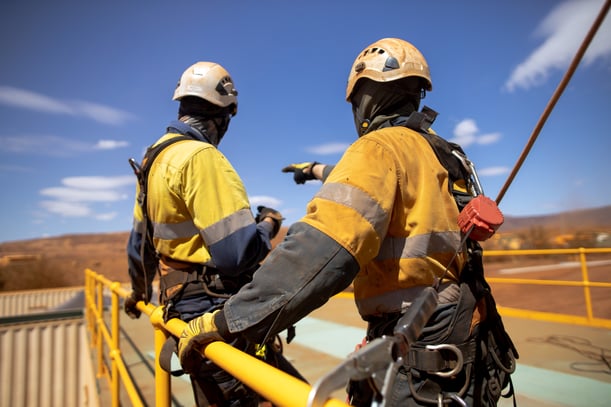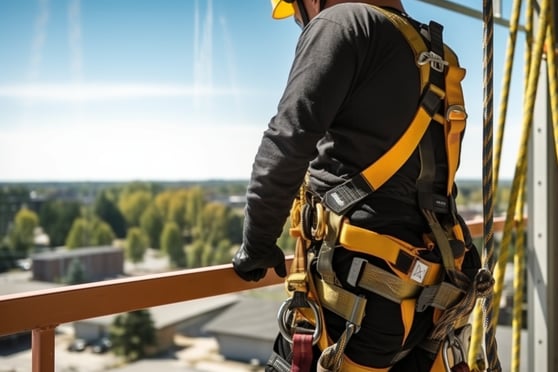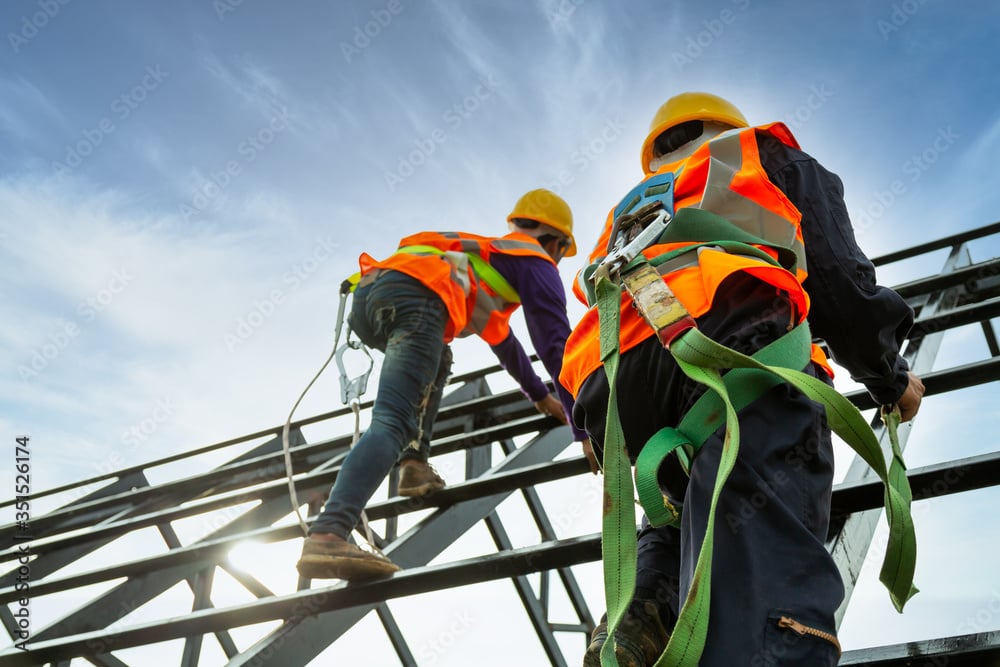Many jobs involve working at heights. From construction workers and roofers to window washers and utility line workers, those who perform their duties above ground level face unique safety challenges. This blog post will delve into the world of working at heights, exploring the potential risks and the crucial safety measures that can mitigate them.
What Does Working at Height Entail?
Working at height encompasses a wider range of activities than you might initially think. It’s not just about scaling skyscrapers or constructing tall buildings. Here are some common examples that demonstrate the diversity of professions that involve working at height:
- Construction: This industry forms a significant portion of jobs where working at height is commonplace. Activities include:
- Ironworkers erecting steel beams for buildings and bridges.
- Roofers installing and repairing roofs on various structures.
- Scaffolders constructing and dismantling scaffolding platforms for workers to access high areas.
- Masons laying bricks and other masonry materials on high walls.
- Electricians and plumbers installing wiring and piping systems in elevated locations within buildings.
- Maintenance and Repair: Keeping infrastructure and equipment running smoothly often requires working at height. Some examples include:
- Wind turbine technicians servicing and maintaining wind turbines, which can reach hundreds of feet tall.
- Telecommunication line workers installing and repairing phone and internet lines strung on utility poles.
- High-voltage electricians repairing and maintaining power lines.
- Building inspectors examining the exteriors of buildings for code compliance or signs of damage.
- Several other professions involve working at height, often as part of their regular duties. These include:
- Painting crews painting the exterior of buildings, bridges, or large structures.
- Window washers cleaning windows on high-rise buildings.
- Tree trimmers and arborists pruning or removing branches from tall trees.
- Installers of signage or satellite dishes on rooftops or other high structures.
- Search and rescue personnel working on cliffs or mountains.
This list is not exhaustive, but it highlights the variety of situations that can be considered working at height. The key factor is the potential for a fall from elevation and the associated risk of injury.

The Dangers of Working at Height
Falls are the leading cause of death and serious injury in the construction industry, and working at height is a significant contributing factor. Beyond the risk of falls themselves, working at height exposes workers to a variety of other potential hazards. Here’s a breakdown of the main dangers involved:
- Falls from height: This is the most obvious and potentially most devastating risk. A fall from even a relatively low height, such as a ladder or a single-story building, can cause serious injuries like broken bones, head trauma, and spinal cord damage. Falls from greater heights can be fatal.
- Falling objects: Tools, materials, or debris dropped from above can strike workers below. This risk is particularly high in construction zones or other environments where multiple workers operate at different levels. Head injuries, broken bones, and even fatalities can occur from falling objects.
- Electrocution: Working near power lines or electrical equipment poses a significant risk of electrocution for those working at height. Direct contact with a live wire can cause severe burns, muscle contractions, cardiac arrest, and even death. Electrical hazards can also be present in unexpected places, such as within older buildings or on rooftops where there may be exposed wiring.
- Slips, trips, and falls: Uneven surfaces, poor weather conditions, or improper footwear can all increase the risk of slips, trips, and falls from height, even on stable platforms. Slips and trips can cause workers to lose their balance and fall from a height, potentially leading to serious injuries.
- Confined spaces: Some jobs at height may involve working in confined spaces, such as inspecting or repairing the interiors of tanks or silos. Confined spaces present a unique set of hazards, including limited air circulation, the risk of oxygen deficiency, and the potential for exposure to toxic fumes or dust.
- Weather extremes: Working at height can expose workers to harsh weather conditions such as strong winds, rain, snow, or extreme heat. These conditions can create slippery surfaces, reduce visibility, or make it difficult to maintain proper footing, all of which can increase the risk of falls.
By understanding these dangers and implementing proper safety measures, employers and workers can significantly reduce the risks associated with working at height.
Mitigating the Risks: Safety Measures for Working at Height
Working at height doesn’t have to be a gamble. By implementing proper safety measures, employers and workers can significantly reduce the risks involved. Here are some key safety practices that can help mitigate the dangers associated with working at height:
- Fall protection systems: This is the primary defense against falls from height. There are various fall protection systems available, each suited for specific work environments and tasks. Some common examples include:
- Guardrails: These provide a physical barrier to prevent falls from edges. They are typically used on rooftops, balconies, and scaffolding platforms.
- Safety nets: These large nets are positioned below work areas to catch workers in case of a fall. They are often used in conjunction with other fall protection systems, such as fall arrest harnesses.
- Personal fall arrest systems (PFAS): These systems include a full-body harness, a lanyard, and an anchorage point. The lanyard connects the harness to a secure anchor point, arresting a fall and preventing the worker from reaching the ground. PFAS are essential for many tasks where workers are not protected by guardrails or nets.
- Planning and risk assessment: Before any work begins at height, a thorough risk assessment should be conducted. This process involves identifying potential hazards specific to the workplace and work activities. Once the hazards are identified, appropriate safety measures can be implemented to mitigate the risks. For example, a risk assessment for roof repair might identify the need for guardrails around the work area, the use of PFAS for workers on the roof, and proper signage to warn others about the ongoing work.
- Training and supervision: Workers must be properly trained in the safe use of fall protection equipment, working at height procedures, and recognizing and mitigating potential hazards. Training should be ongoing and address the specific types of fall protection systems used in the workplace. Adequate supervision is also essential to ensure adherence to safety protocols. Supervisors should monitor work activities and ensure workers are using fall protection equipment correctly.
- Proper equipment: The right equipment for the job is crucial. This includes using ladders with proper load ratings and secure footing, using the right fall protection gear for the specific task (e.g., selecting a harness with the appropriate weight capacity), and ensuring all equipment is inspected and maintained regularly. Damaged or outdated fall protection equipment can fail and leave workers vulnerable to falls.
- Safe work practices: In addition to the measures mentioned above, several safe work practices can further reduce risks:
- Always plan your work and ensure a safe method statement is in place.
- Perform pre-shift inspections of all fall protection equipment to ensure it is in proper working order.
- Maintain good housekeeping on work surfaces to prevent slips, trips, and falls.
- Communicate clearly with colleagues about work activities to minimize the risk of dropped objects or inadvertent interference.
- Be aware of weather conditions and take precautions when working in extreme weather.

By following these safety measures and fostering a culture of safety awareness, employers and workers can create a work environment where working at height is a calculated risk, not a gamble with lives. Remember, safety is not a suggestion; it’s a necessity.
Working Together for a Safer Workplace
Working at height is an essential part of many industries, but it should never come at the cost of worker safety. By prioritizing safety measures, fostering a culture of risk awareness, and ensuring proper training and equipment, employers and workers can collaborate to create a safer working environment for everyone. Always keep in mind that safety isn’t a luxury; it’s a necessity, especially when your work takes you up high.

